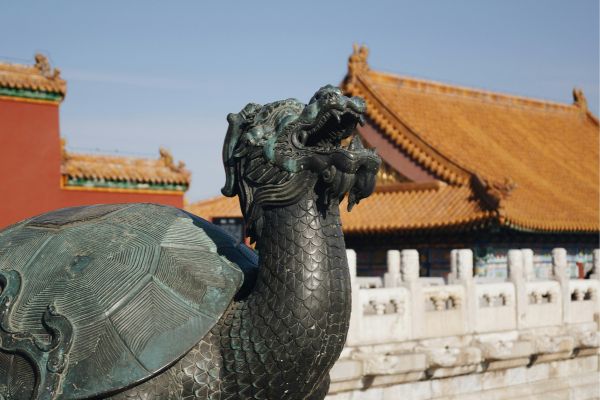
Since Justice Zhou Qiang (周强) served as the president of the Supreme People's Court (SPC) of China in 2012, the Chinese E-Justice(informationization of the court, 法院信息化)has become the two most important tasks of Chinese courts besides the judicial reform. In China's latest judicial reform (2014-2017), information technology has also become one of the main means to achieve the goal of judicial reform: 35 of the 65 judicial reform tasks rely on information technology.
Therefore, if you want to know how Chinese courts work, you need to understand how Chinese courts are informationized.
The SPC established a trial management information system that connects all courts across the country, and local courts have also developed many unique functions by their own based on the said system. Generally, the information system of Chinese courts mainly includes the following subsystems:
1. Office Automation System
The system can assist judges in handling cases, such as: pushing the judgments of the same type of case to the judges for the reference (i.e., the “similar cases pushing” mechanism); automatic judgment drafting, and automatic errors correcting in the judgment. Chinese courts want to incorporate artificial intelligence into the system to assist judges in making decisions, to improve their efficiency, or to alert judges for abnormal decisions to supervise their behaviors.
The system can also record all information during the case process in real time, so that every trace of each case is stored in the system. These traces include information about each node of the judge handling the case, and the supervisor's supervision of the judge. The former type of trace is recorded to supervise the judge; the latter type of trace is recorded to supervise the supervisor and prevent him from interfering with the judge.
2. Trial Management System
Since the information of each judge and each case is recorded in the office automation system, and the system has been connected to all courts in the country, the SPC can know all courts, all judges, and all cases in the country in real time, and the court leadership can also get real-time information about each judge and each case. This has further strengthened the management capacity of Chinese courts. In other words, the hierarchical structure of Chinese courts has been further strengthened.
The SPC also plans to collect judicial data through the system and develop AI systems based on big data. The SPC hopes that the AI system can realize two major functions: one is the aforementioned “similar cases pushing”, that is, the similar cases and their processing methods are selected from the historical data to be used for judges' reference and assist in their decision; the second is big data analysis, that is, the statistics and analysis of judicial data, which can provide reference for the SPC, government’s decision-making and legislation of the legislature, and can also predict social and economic trends.
3. China Judicial Process Information Online
The SPC has established the “China Judicial Process Information Online” (https://splcgk.court.gov.cn/gzfwww/), and requires all courts across the country to provide the parties and their lawyers with information on the trial process of their case, including: information on each node in the proceedings, transcripts, audio and video of the trial, case files, and all the legal documents that should be served to the parties.
(CJO Note: Up to now, Hebei, Jiangsu, Qinghai, and Ningxia have opened services in China Judicial Process Information Online, and other provinces (autonomous regions and municipalities) are on their way to opening such services.)
4. China Judgments Online
The SPC has established “China Judgments Online” (http://wenshu.court.gov.cn/) on which the judgment documents of all courts in the country are disclosed to the public. Through this platform, the SPC hopes to enable the public to understand the work of the court through these instruments, while to supervise the judges through the opinions of the public and the media on the instruments.
5. China Trials Online
The SPC has established “China Trials Online” (http://tingshen.court.gov.cn/), and all courts across the country can broadcast live trials on the platform. Anyone can watch these live videos from anywhere on the Internet.
6. China Enforcement Information Online
Chinese courts have long faced the dilemma that judgment documents are difficult to be enforced. This dilemma has caused many judgment creditors to fail to prompt judgment debtors to fulfill their obligations with the help of the courts, resulting in a reduction in market efficiency in China. To this end, the SPC initiated a plan to resolve the enforcement dilemma within 2-3 years. In this plan, “China Enforcement Information Online” (http://shixin.court.gov.cn/) is established, on which the enforcement procedures and the information of the judgment debtors are published, as one of the means to procure the judgment debtor to fulfill its obligations.
At present, the SPC refers “China Judicial Process Information Online”, “China Judgments Online”, “China Trials Online”, and “China Enforcement Information Online” as the four major platforms for open justice, and regards them as the most important means for open justice of Chinese courts.
7. Online Enforcement Inquiry and Control System
Similarly, in order to solve the aforementioned enforcement dilemma, the SPC has cooperated with various government departments to establish the online enforcement inquiry and control system. All courts in the country can conveniently inquire the personal information and property information of the judgment debtor on the system and take timely control measures on the property.
8. Litigation Service Platform
The SPC and some local courts have respectively established an online platform for litigation services. On these platforms, the parties concerned can apply for case docket, inquire the case information, access case files, receive documents in electronic form, make an appointment to meet judges, submit evidence and documents, and even participate in remote video trials on the platform.
The SPC also encourages courts throughout the country to provide terminal equipment at their premises, which will provide friendlier human-computer interaction tools to facilitate litigation services.
9. Judicial Assistance Management Platform
The SPC has established a judicial assistance management platform. On this platform, the SPC can directly manage foreign-related and Hong Kong, Macao and Taiwan-related judicial assistance cases in all courts across the country. Prior to this, petitions for judicial assistance in civil and commercial matters such as service, evidence-taking, and the recognition and enforcement of judgments required cooperation from the SPC to multiple local courts. This leads to a lower efficiency of judicial assistance. On this platform, courts can conduct online review, processing and enquiries of judicial assistance, thereby increasing the efficiency of international judicial assistance.
10. Human Resource Management System
The SPC has established a human resources management system and requires all courts throughout the country to manage its staff, especially judges, within the system. The court can learn about the work of its judges on the system, thereby assessing the performance of the judges, or discovering and punishing the judges’ misconducts.
11. Complaint and Grievance System
The SPC has established a website for reporting (jubao.court.gov.cn) through which the public can complain about various violations and offenses of court personnel.
The SPC also established a complaints and proposals management system (ssxf.court.gov.cn). The parties concerned can use the system to appeal against the effective judgment, and even to communicate with the SPC judges and the judge who made such judgment through the system.
12. Social Media
The SPC and various courts across the country have established accounts on several social media in China. The courts publish information of major cases, judicial interpretations issued by the SPC, and work plans of the courts, etc. on social networks.
This post is also reproduced in the China Law & Practice, on 10 Jan 2019.
If you would like to discuss with us about the post, or share your views and suggestions, please contact Ms. Meng Yu (meng.yu@chinajusticeobserver.com ).
If you wish to receive news and gain deep insights on Chinese judicial system, please feel free to subscribe to our newsletters (subscribe.chinajusticeobserver.com ).
Contributors: Guodong Du 杜国栋 , Meng Yu 余萌









